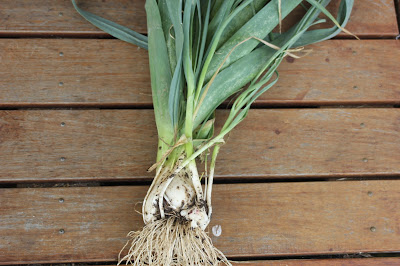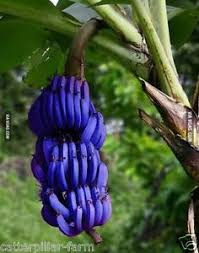I was given seven small regular leeks by a very lovely neighbour when we moved to this house. I didn't ask what the variety was. I planted them in a raised garden bed and decided to plant seven perennial leeks in the next row as a comparison. Both rows contained seven similar sized leeks.
Both sets of leeks were planted 30/10/2016. I then left them for a year and did nothing other than water them every so often. I was careful not to dig up and eat any leeks from either of these rows during this time.
I dug up both sets of leeks on 27/10/2017 and took pictures of both sets. I figured 12 months of growth (and relative neglect) should give me a decent comparison.
 |
| Leek comparison: Regular leeks on left, Perennial leeks on the right |
Regular leeks
The regular leeks didn't do very well for me. I started with 7 plants each about the size of a pencil, after 12 months I ended up with two edible sized leeks, one small leek, and one small leek bulb growing off the base of one of the large leeks that could be replanted (you can't see the bulb in the photo).
 |
| Regular leeks |
Perennial Leeks
The perennial leeks did a lot better for me. Again I started with seven leeks each about the size of a pencil. Each of the seven leeks grew to a large size. At this size I usually wouldn't eat these leeks as they are too large. Larger leeks tend to be tough so we often eat a lot of smaller leeks which are more tender. As well as being large each of the seven grew 30 to 50 baby leeks of various sizes.
You will notice that each of these leeks has a rounded base. When we cut these leeks up to eat for dinner we noticed that each of them had many, many leek bulbs in the base. These leeks would have died down over summer and when the weather cools each of the bulbs would have sprouted into a new plant.
 |
| Perennial Leeks |
 |
| Perennial leek - note the baby leeks growing from the base |
Perennial Leek vs Regular Leek Comparison Results
The first and most obvious thing I noticed from this comparison is that I obviously don't know how to grow leeks! I wouldn't have planted seven leeks and ended up with three leeks if I knew what I was doing. Considering how many years I have been growing leeks this came as a surprise to me.
The second thing I noticed is (considering that I don't know how to grow leeks) the perennial leeks gave a great yield. Look at the photo, there are plenty of edible sized leeks in there, and there are plenty of tiny leeks to replace them.
I have been growing perennial leeks for many years and always get large consistent crops. I never give them much attention and there are always some leeks large enough to eat, and there are always plenty of small leeks to replace any I eat.
I want vegetables that feed my family and don't need much attention from me, so perennial leeks are great. I want vegetables that reproduce themselves with no effort from me, and perennial leeks are great for this. I want vegetables that will always be there for me even if I forget about them and don't look after them, and perennial leeks are great for this. For all of these reasons I am not sure if I will grow regular leeks again. Perennial leeks are just so easy and productive. With perennial leeks you plant once and harvest forever, what is not not love!
Perennial leeks for sale in Australia














































